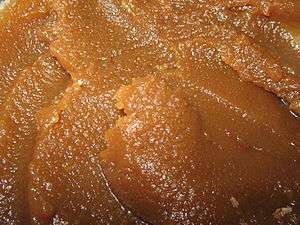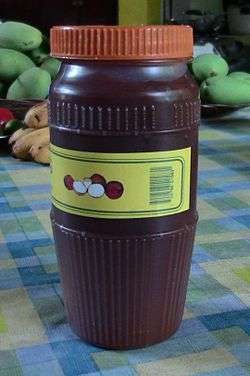Coconut jam
|
A jar of coconut jam sold in the Philippines. | |
| Alternative names | Srikaya, kaya |
|---|---|
| Type | Spread |
| Place of origin | Malaysia, Indonesia and the Philippines |
| Main ingredients | Coconut, sugar, eggs |
|
| |
Coconut jam (Malay: kaya; Indonesian: seri kaya, srikaya; Tagalog: matamís sa báo, matamís na báo, or kalamay-hatì; Hokkien: 咖吔 ka-ia) is a food spread or fruit curd made from a base of coconut milk, eggs and sugar. It is wildly popular in Southeast Asia, mainly in the Philippines, Malaysia, and Singapore, and in Palembang in Indonesia.
The word for coconut jam in the Malay language, kaya, means rich, referencing the texture of the popular food. It could possibly be an adaptation of the Indian word 'khoya' or 'kova', which is an Indian milk custard used as a base for sweet desserts, as in ancient times the Southern Indians traded extensively with the Malay archipelago peoples, thus contributing a fair amount to the cuisine, faith and language of the Malays. The kaya has a custard-like texture like khoya.
Malaysia, Indonesia, Brunei and Singapore

To the Malaysians, Indonesians and Singaporeans, kaya,[1] also called srikaya (coconut egg jam), is a sweet creamy coconut spread made from coconut milk (also known as santan) and duck or chicken eggs (which are flavored with pandan leaf and sweetened with sugar). The colour varies depending on the colour of the egg yolks, the amount of pandan, and the extent of the caramelisation of the sugar. As a popular local spread, kaya is typically spread on toast to make kaya toast and eaten in the morning,[2] but is also enjoyed throughout the day. Kaya can be found in most kopitiam and night markets.
Different varieties available include the nyonya kaya, which is of a lighter-green colour, and Hainanese kaya, which is a darker brown kind that uses caramelised sugar and is often further sweetened with honey.
In Malaysia, Indonesia and Singapore, kaya is also used as a topping for several desserts including pulut taitai or pulut tekan, a dessert of sweet glutinous rice coloured blue with butterfly pea flowers (bunga telang), and pulut seri muka, a similar dessert but coloured green due to the pandan leaves ingredient. It is also used with glutinous rice to make kuih seri kaya.
Philippines
Philippine coconut jam, meanwhile, is made from coconut cream (the first and second press of grated coconut meat) and cane sugar extract or molasses (treacle). It is often eaten on toast or pandesal and is used to make kalamay.
Thailand

The kaya of Thailand is called sangkhaya (Thai: สังขยา, pronounced [sǎŋkʰàjǎː]) in Thai. There are two major types of kaya eaten in Thailand. One type is more liquid than the other, while the less thick kaya is similar to what is eaten in Malaysia or Singapore. People either spread it on steamed or toasted bread or dip the bread into kaya. This kind of kaya is commonly sold by street vendors but has recently been brought into tea and coffee shops. This type of kaya is normally called "khanom pang sangkhaya", literally translated as "bread and kaya".
Another type is a concoction that has a less sticky and more custard-like texture. It is sometimes called "coconut custard" in English and is used to make sangkhaya fakthong (สังขยาฟักทอง, [sǎŋkʰàjǎː fáktʰɔ̄ːŋ]; sangkhaya maryu in Lao), sangkhaya pumpkin or custard pumpkin, khao niao sangkhaya (ข้าวเหนียวสังขยา, [kʰâːw nǐaw sǎŋkʰàjǎː]), glutinous rice with sangkhaya, and sangkhaya maphrao (สังขยามะพร้าว, [sǎŋkʰàjǎː māpʰráːw]), sangkhaya served in a coconut.
See also
References
- ↑ Julie Wong (3 August 2014). "Kaya: A rich spread". The Star. Retrieved 16 April 2015.
- ↑ Michael Aquino. "Roti Kaya - a Favorite Kopitiam Breakfast throughout Malaysia and Singapore". About Travel. Retrieved 16 April 2015.
External links
- Famous Thai Dishes including photos of Thai sangkhaya desserts
- Not your usual kaya with three recipes made with palm sugar, pumpkin and taro

